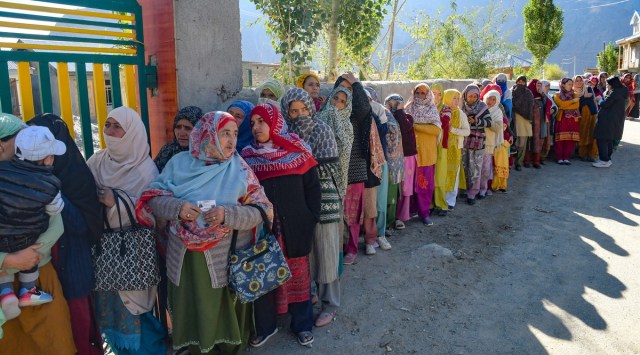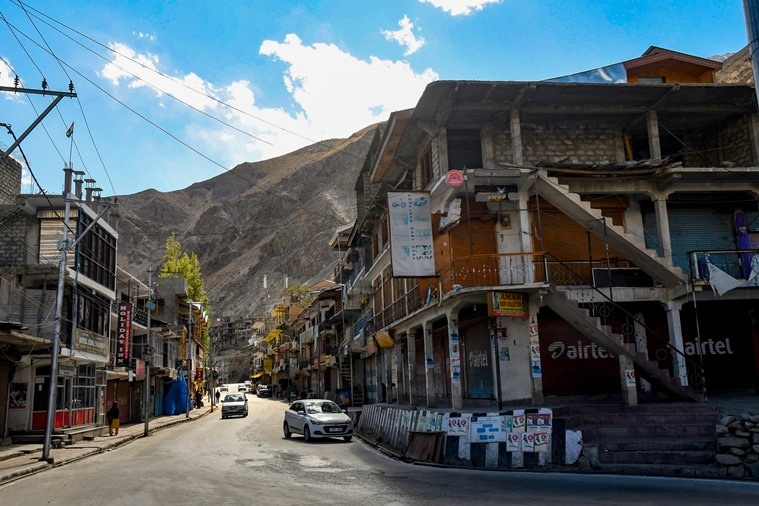Hopes and anxieties converge as Kargil steps out to vote
Polls drew to a close at 4 pm on Wednesday. Kargil now awaits results on October 8 to decide not just its representatives for the next five years but also its future as a Union Territory.
 Voters queue up outside a polling booth to cast their votes during the Ladakh Autonomous Hill Development Council Election, at Kaksar village in Kargil on Wednesday. (ANI Photo)
Voters queue up outside a polling booth to cast their votes during the Ladakh Autonomous Hill Development Council Election, at Kaksar village in Kargil on Wednesday. (ANI Photo) Voters in the Kargil area of Ladakh turned out in large numbers to elect representatives to the Ladakh Autonomous Hill Development Council (Kargil), the first electoral exercise in the area since August 2019.
Kargil recorded a polling percentage of 77.6 percent on Wednesday, the district administration said. Voters queued up at the stations before polling started at 8 am, and 65 percent polling had been completed till 1 pm. Of the 26 constituencies electing representatives to the LAHDC, the highest turnout was recorded at Saliskut with 90 percent votes polled.
At polling booths, several voters expressed dissatisfaction over the functioning of the region as a Union Territory and said they are exercising their franchise to empower the councils to protect their identity and their land.
The National Conference-Congress combine hopes to leverage this discontent with the administration and the Centre. NC vice-president Omar Abdullah termed this election a “referendum” against the Centre’s move to separate Ladakh from J&K.
 A view of the closed market during the Ladakh Autonomous Hill Development Council Election, in Kargil on Wednesday. (ANI Photo)
A view of the closed market during the Ladakh Autonomous Hill Development Council Election, in Kargil on Wednesday. (ANI Photo)
Still coming to terms with the shift in the administrative structure in Ladakh as a UT, Najaf Ali, a resident of Kaksar village, said: “Now the Centre governs through the Lieutenant Governor and we do not have a stake in our own futures and those of our children.” He said that earlier, people could petition their MLAs or the chief minister of their state, “but now, one cannot meet the LG or the MP or go meet ministers in the central government”.
At the same village, women waiting in queues said that since August 2019, when Ladakh was separated from the former state of Jammu and Kashmir and took shape as a UT, “there is so much talk of development, but we still struggle for basics”. One of the voters, Zubaida, said she and others from her village gather around two taps supplying drinking water at 6 am. “In the winter, we carry water up from the river on horseback since the taps are frozen,” she said.
“Hum khush nahin hain (We are not happy). We would like to be a part of J&K as we were before,” she said.
For irrigation of their fields, locals said, “we have to carry a white flag down to the canals that are directly opposite Pakistani military posts so we can water our fields”.
Muzaffar Ali, 71, added that “despite so much talk of development, life is the same”. However, he added, “I am here to exercise my democratic right.”
Seven kilometres away, at the polling booth in Chanigound, 50-year-old Shahid Bano, the first from her village to pass the 10th grade, cast her vote “for better education”. She said that after Kargil became part of the Ladakh UT, “students initially struggled as schools remained shut due to the agitation that began almost immediately after August 5, 2019, and then the onslaught of Covid”. She said the lack of jobs is another pressing issue. An assistant at a small library in her village, she said, “I have asked everyone to come and vote today.”
 Voters on their way to a polling booth to cast their votes during the Ladakh Autonomous Hill Development Council Election, in Kargil on Wednesday. (ANI Photo)
Voters on their way to a polling booth to cast their votes during the Ladakh Autonomous Hill Development Council Election, in Kargil on Wednesday. (ANI Photo)
Many youth in the voting lines blamed the Centre for the lack of opportunities in Ladakh. Mohammad Parvez, 30, said that after completing his B.Comm at Delhi University, he moved back to look for jobs within J&K, hoping to stay close to his family and help out financially. Soon afterwards, constitutional changes of August 5, 2019 took shape. “I have been robbed of any job prospects. I cannot apply for jobs in Kashmir like earlier and this fact unifies Kargil and Leh, which would earlier never converge on their demands.” He now runs a small shop in the Kargil market.
While Parvez’s vote is to “keep BJP out”, 63-year-old Haji Mohammad Ali said it is the BJP “that will provide all round development for the area”.
Another young voter, 21-year-old Khair-un-Nisa, readied to cast her first vote: “After I graduate, I will perhaps continue my education since there are no posts being advertised in Kargil at the moment.” She said she cannot consider applying for jobs in other parts of the country because “my family cannot support me financially”.
While the elections are being fought around the issue of development in the Kargil region, keeping the BJP out of the 30-member council is the key objective for all other parties.
Lodged between Srinagar and Leh, where the last council polls were held in 2020, Kargil is affected by the politics of both regions and its population of over 1.40 lakh (majority Shia) has been struggling to find alignment.
In the last council in Kargil, the BJP had three members. This time, the party has fielded 17 candidates.
The 30-member council has 26 elected and four nominated members. In the outgoing council, while the NC had 10 members, the Congress had 8 and Independents 5.
Polls drew to a close at 4 pm on Wednesday. Kargil now awaits results on October 8 to decide not just its representatives for the next five years but also its future as a Union Territory.







